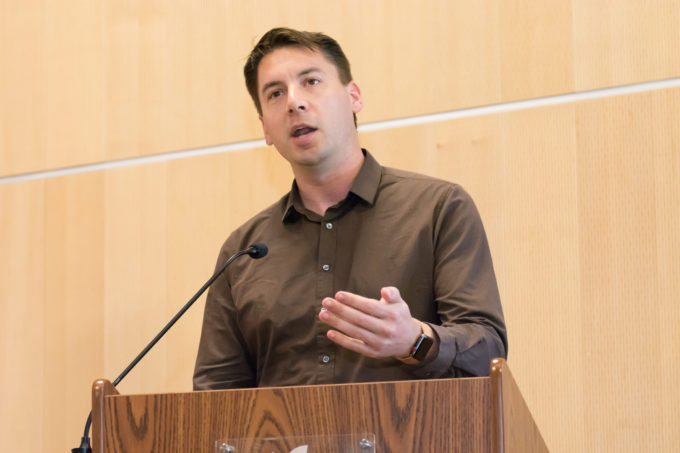The Circularity Challenge is a six-month accelerator program designed to advance innovative solutions to enable a circular economy. The five participants are disrupting the plastics, energy storage, and recycling value chains. The Circularity Challenge is run by Greentown Launch—Greentown Labs’ internal accelerator—and BASF, and supported by Stanley Black & Decker.
There’s a huge opportunity—and need—for better lithium-ion battery recycling. Less than three percent of lithium-ion batteries are recycled, and the few facilities that do recycle these batteries can only recover a handful of elements, according to Ryan Melsert, CTO of American Battery Metals Corporation. That means small amounts of the elemental metals used to manufacture these batteries are ever reintroduced back into the supply chain.
The people who have the best skill set to recycle these lithium-ion batteries are the same people who manufacture them, Melsert argues. But battery manufacturers are fully focused on scaling up production to meet increasing demands for electric vehicles and energy storage systems, so they need other companies to develop better recycling systems.
That’s where American Battery Metals Corporation comes in. They’re battery experts from start to finish: the initial harvesting of battery metals; the purification of these feedstocks into battery grade materials; the synthesis of these feedstocks into active and inactive components; the manufacturing of the cells themselves; and the manufacturing of these cells into integrated modules and packs.
Using this wide breadth of knowledge, the company has developed a full recycling process that can recover over 95 percent of each of the elemental metals that are integral to manufacturing new batteries.
“If you consider an end-of-life battery itself as its own mine, it has every element needed, and in exactly the right ratio, to make a new battery,” Melsert explains. “An individual battery cell is a closed system, so while over time the compounds degrade, the elemental composition of the battery is exactly the same at the end-of-life as the day it was manufactured. Additionally, it has fewer impurities as a feedstock than when starting off with a virgin material, which greatly simplifies the extraction processes. It’s the perfect feedstock to extract elements for the manufacturing of new battery cells.”
The increasing demand for batteries makes it even more crucial to source their materials sustainably. In addition to battery recycling, American Battery Metals Corporation has developed a more environmentally sustainable and low-cost method of extracting battery materials from virgin ores and brines. This means the company’s environmental impact is three-fold: it eliminates end-of-life batteries from being sent to landfills as hazardous waste, it displaces the need to extract virgin materials by reintroducing recycled feedstocks back into the supply chain, and when it does extract elements from virgin materials, it uses innovative processes that are environmentally sustainable.
American Battery Metals Corporation found out about the Circularity Challenge at a Greentown Labs EnergyBar networking event. Melsert says he was excited to work with BASF because of its demonstrated commitment to battery circularity and its reputation as one of the highest quality battery material manufacturers in the world.
“Our efforts are very complementary—we can help to provide the crucial last piece in the chain needed to enable a truly closed loop use of these elemental metals in a circular fashion,” he says. “BASF is very clearly not just going through the motions here, they’re not just looking for publicity. They’re genuinely interested in securing new supplies for their material manufacturing and doing so in a sustainable fashion.”
Melsert has had the chance to work extensively with BASF in a way that would be unlikely outside of the Circularity Challenge.
“The best part is that there are seven or eight different groups within BASF that we’re working with,” Melsert says. “It’s every point within the production circle. We’re working with the material R&D team designing the next generation of active materials, the procurement group sourcing battery grade feedstocks for the global manufacturing facilities, the precursor and active material manufacturing groups, the metals and catalyst recycling teams, and several support teams that are integral to making such a cross-functional system come to commercialization.”
American Battery Metals Corporation began working in Greentown’s wet lab during the Circularity Challenge. BASF is sponsoring American Battery Metals Corporation’s bench.
In 2020, American Battery Metals Corporation will open a pilot plant in Nevada that will be able to recycle 20,000 tons of batteries annually. Last year, a total of 90,000 tons of lithium-ion batteries were recycled worldwide, according to Melsert.
Greentown Labs is a community of bold, passionate entrepreneurs creating solutions for today’s biggest climate and environmental challenges. Located in Somerville, Mass., Greentown Labs is the largest cleantech incubator in North America, operating a 100,000 sq. ft. campus comprised of prototyping and wet lab space, shared office space, a machine shop, electronics lab, and a curated suite of programs and resources. Greentown Labs is home to more than 100 startups and has supported more than 250 since its inception.


